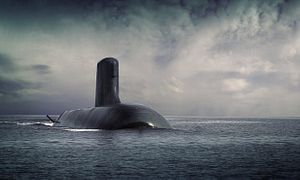The Royal Australian Navy’s (RAN) new fleet of diesel-electric attack submarines will likely be fitted with a combat system by U.S. defense contractor Lockheed Martin, which beat out U.S. rival Raytheon Co.
According to a September 30 press release by the Australian Department of Defense, Lockheed Martin Australia emerged as the preferred bidder to supply the combat system for 12 Shortfin Barracuda Block 1A submarines, a diesel-electric derivative of French shipbuilder Direction des Constructions Navales Services’ (DCNS) Barracuda-class nuclear attack submarine under the RAN’s so-called SEA 1000 Future Submarine Program.
“Lockheed Martin Australia will be our Combat System Integrator to partner with Defense and DCNS to design and integrate the combat system of our Future Submarine, which meets our unique capability requirements,” said Australia’s minister of defense, Marise Payne. “By partnering with an Australian-based company with strong links to the United States we will ensure that we get the best Australian and U.S. technology, while ensuring that our sensitive technology is protected.”
The combat system is the heart and brain of a submarine. It consists of various components including sensors (e.g., sonar), weapons (e.g., torpedoes), and a database. The capabilities of the combat system are some of the most highly guarded secrets of a submarine.
As I reported previously, DCNS came under scrutiny over the summer when the French shipbuilder suffered a massive leak of documents detailing the top-secret combat capabilities of the Indian Navy’s Scorpene-class (Kalvari-class) diesel-electric attack submarine, which DCNS has been building with the support of India’s state-run Mazgaon Docks Limited (MDL) in Mumbai.
“The 22,400 pages leak includes highly classified documents marked ‘Restricted Scorpene India’ outlining the Scorpene-class sub’s diving depths, range, and endurance, magnetic, electromagnetic and infrared data, and details of the submarine’s combat system, including the torpedo launch system,” I explained elsewhere.
The Australian government expressed concern over the leaks and pressed DCNS to step up operational security. As a result DCNS Australia announced on August 26 that it will establish an operational Security Committee by the end of 2016 (See: “Australia Warns French Submarine Maker After Massive Security Leaks”).
The 12 submarines (save some specialized parts) will be built in Adelaide, the capital city of South Australia and home base of the Australian Submarine Corporation (ASC). “Today’s announcement again shows the Turnbull Government is setting a cracking pace on delivering on its commitment to build 12 regionally superior submarines in Adelaide,” Australian Defense Industry Minister Christopher Pyne said on September 30. “I am pleased that a team of Australian companies will integrate the Future Submarine Combat system in a dedicated facility in Adelaide.”
The principal task of Lockheed Martin will be to integrate the U.S.-made AN/BYG-1 Combat System into the subs of the new RAN’s new Barracuda-class. “The AN/BYG-1 is installed on the U.S. Navy’s Los Angeles, Seawolf, Virginia and SSGN-class submarines, as well as on the Royal Australian Navy’s Collins-class submarines,” according to the General Dynamics website. U.S. defense contractors General Dynamics and Raytheon will most certainly play a major role in the integration process given that the companies were also involved in integrating the combat system aboard U.S. Navy subs.
































